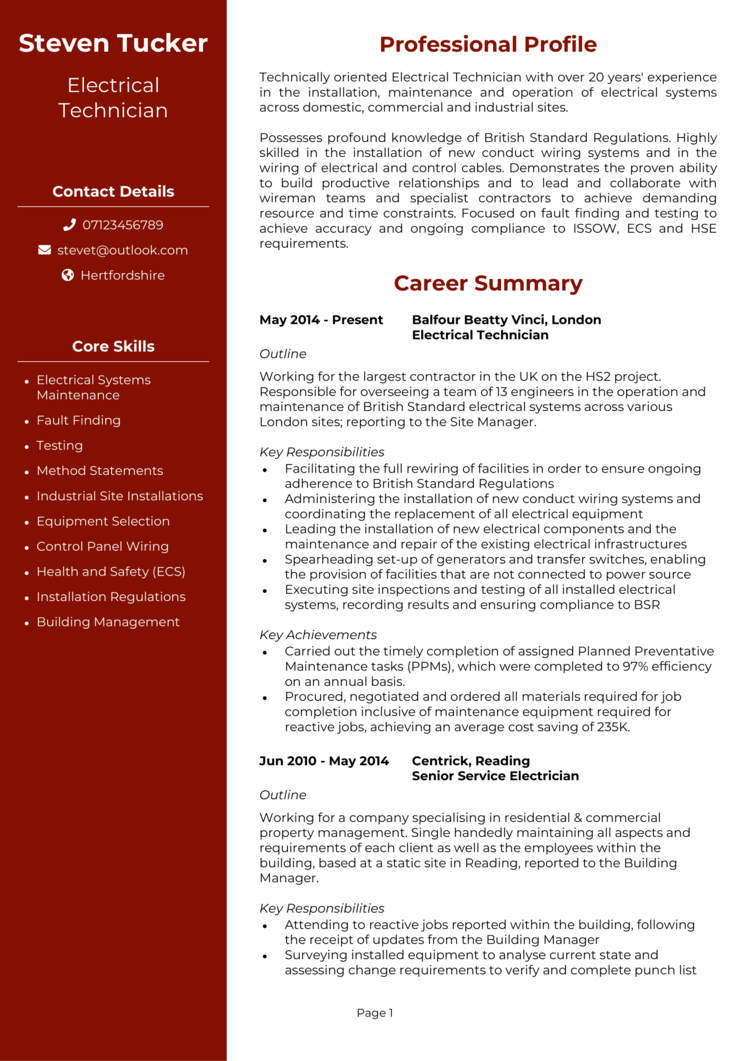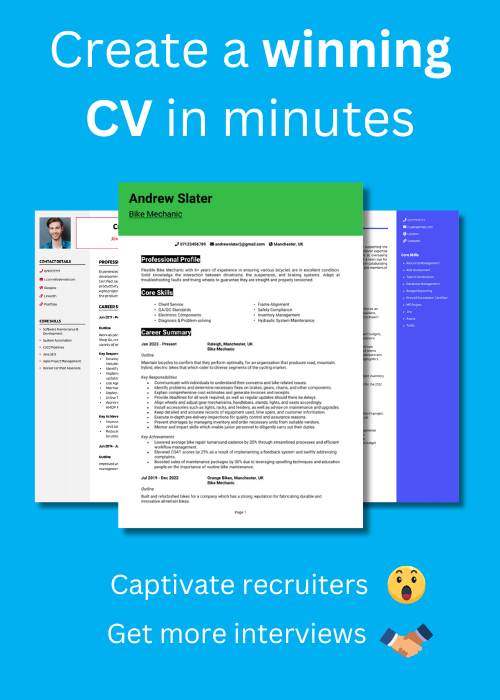Ready to spark some interest with your CV? As an electrician, you’re the expert in wiring, fixing, and lighting up spaces. But before you can illuminate homes and businesses, you’ll need a CV that shows hiring managers you’ve got the skills to get the job done safely and efficiently.
This guide, complete with Electrician CV examples, will help you craft a CV that highlights your technical expertise, problem-solving abilities, and dedication to delivering high-quality work.
Electrician CV

Self-Employed Electrician CV

Industrial Electrician CV

Electricians Mate CV

How to write your Electrician CV
Learn how to create your own interview-winning Electrician CV with this simple step-by-step guide.
Writing a CV for an electrician job is about more than listing qualifications. Employers want to see your practical experience, technical skills, and ability to handle challenges on-site.
This guide will show you how to present your expertise in a way that grabs a recruiter’s attention and secures interviews for the roles you’re aiming for.
Electrician CV structure


Your Electrician CV should be as neat and organised as your wiring – no crossed lines or tangled sections. Recruiters need to see your skills and qualifications at a glance: if your CV isn’t organised, they’ll switch off faster than a tripped breaker.
Here’s how to structure your Electrician CV:
- Name and contact details – These personal details should go right at the top so employers can easily reach you. Adding a photo is optional.
- Profile – Start with a snapshot of your skills, career highlights, and other details like your safety record.
- Core skills – Focus on core skills like installation and testing, making it easy for employers to see your key strengths at a glance.
- Work experience – Walk through your job history, beginning with your latest position and moving backwards.
- Education – Outline your education and certifications, focusing on those most relevant to the role.
- Additional info – You can add hobbies and interests or activities here that reflect your technical skills or problem-solving mindset.
Electrician CV format


A well-formatted CV is as essential as a properly wired circuit – if it’s messy or unclear, it just won’t work. Recruiters need a CV that’s easy to navigate and highlights your strengths: even a great electrician will miss out if visual mistakes short-circuit their CV’s impact.
Here’s how to format your Electrician CV:
- Bullet points – Break down your key information into skimmable bullet points for quick comprehension.
- Divide sections – Ensure each part of your CV layout is clearly defined with headings and consistent formatting.
- Use a clean font – Opt for a clean, clear font to make your CV polished and easy to read.
- Keep it the right length – 2 pages is ideal to provide all the essential information while staying sufficiently concise.
Writing an Electrician CV profile


Your profile is your chance to highlight your skills, experience, and dedication to quality work. For an electrician, this means demonstrating your technical expertise and reliability.
Electrician CV profile examples
Profile 1
Skilled Electrician with five years of experience in residential wiring, installations, and maintenance. Proficient in diagnosing electrical faults, adhering to safety regulations, and delivering high-quality workmanship to meet client needs.
Profile 2
Reliable Electrician with three years of experience in commercial and industrial settings, specialising in large-scale electrical systems. Skilled in installing and maintaining wiring, circuit breakers, and control panels. Proficient in reading blueprints and ensuring compliance with industry standards.
Profile 3
Experienced Electrician with over eight years of expertise in renewable energy systems, focusing on solar panel installations and energy-efficient upgrades. Skilled in troubleshooting, system optimisation, and implementing sustainable energy solutions.
What to include in your Electrician CV profile
Here are some tips on what to include in your Electrician CV profile:
- Where you’ve worked – Make sure you specify which industries or projects, such as residential, commercial, or industrial work you’ve worked in before.
- Your top qualifications – Highlight your important certifications like NVQs or City & Guilds.
- Key skills – List those abilities like electrical installations, troubleshooting, and safety compliance.
- Safety record – Reference your commitment to adhering to regulations and ensuring safe work practices.
- Specialised expertise – Mention experience in areas like renewable energy or smart home systems.
Core skills section


Your core skills section is like your toolbox – packed with everything recruiters need to see you’re the right fit for the job.
For electricians, this section should highlight practical skills and technical knowledge, tailored to the role you’re applying for.
Best skills for your Electrician CV
- Electrical Installations – Installing wiring, outlets, and lighting systems for residential and commercial buildings.
- Fault Finding – Diagnosing and repairing electrical issues efficiently.
- Regulation Compliance – Ensuring all work meets safety standards and building codes.
- Panel Upgrades – Upgrading electrical panels to handle increased power loads.
- Circuit Design – Planning and implementing electrical circuits for new constructions or renovations.
- Smart Home Systems – Installing and maintaining smart lighting, heating, and security systems.
- Renewable Energy Systems – Setting up and maintaining solar panels or other green energy solutions.
- Inspection and Testing – Performing safety inspections and issuing compliance certificates.
- Blueprint Interpretation – Reading and following technical diagrams and blueprints.
- Customer Relations – Explaining technical issues clearly and providing exceptional service.
Work experience


Your work experience section is where you prove you’re not just flipping switches – you’re the one keeping the lights on. Showcase the practical application of your electrical skills. Focus on the projects you’ve completed, the responsibilities you’ve handled, and the results you’ve achieved.
List these roles with the most recent ones at the top, as those are considered the most relevant.
What’s the correct way to structure job history on your CV?

- Outline – Provide an overview of the company, your role, and the type of projects you worked on.
- Responsibilities – Highlight tasks like installations, troubleshooting, or compliance checks. Use action verbs like “installed,” “repaired,” or “tested.”
- Achievements – Showcase measurable results, such as reducing power outages, increasing energy efficiency, or completing projects ahead of schedule. Always include figures where possible to add impact.
Job examples for an Electrician
Residential Electrician | BrightHome Electricals
Outline
Installed and maintained electrical systems in residential properties, ensuring safety and compliance with local regulations. Delivered high-quality services to homeowners and small property developers.
Responsibilities
- Installed wiring, outlets, and lighting fixtures for new home construction projects.
- Diagnosed and repaired electrical faults, including circuit breakers and wiring issues.
- Performed routine maintenance to ensure safe and efficient electrical systems.
- Collaborated with clients to design and implement custom electrical solutions.
- Provided detailed cost estimates and timelines for electrical projects.
Achievements
- Completed 95 percent of projects ahead of schedule with minimal disruptions.
- Reduced client energy costs by 15 percent through efficient system upgrades.
- Praised by clients for delivering exceptional customer service and workmanship.
Commercial Electrician | PowerTech Services
Outline
Worked on large-scale electrical installations and maintenance for commercial properties, ensuring seamless operations and minimal downtime. Focused on adhering to strict safety protocols and industry standards.
Responsibilities
- Installed and maintained wiring and control systems for office buildings and retail spaces.
- Conducted regular inspections to ensure systems complied with electrical codes.
- Diagnosed and repaired faults in industrial-grade machinery and equipment.
- Designed and implemented electrical systems for new commercial construction projects.
- Worked closely with contractors and engineers to meet project specifications.
Achievements
- Reduced maintenance costs by 20 percent through proactive system upgrades.
- Delivered a £500,000 commercial wiring project two weeks ahead of schedule.
- Received commendation from management for ensuring zero safety incidents.
Electrician | GreenSpark
Outline
Specialised in installing and maintaining renewable energy systems, including solar panels and energy-efficient electrical upgrades. Focused on providing sustainable energy solutions for residential and commercial clients.
Responsibilities
- Installed solar panels, inverters, and energy storage systems for homes and businesses.
- Conducted energy audits and recommended efficient solutions to clients.
- Troubleshot and repaired faults in renewable energy systems, ensuring optimal performance.
- Provided training to clients on maintaining and using their new energy systems.
- Collaborated with suppliers to source high-quality and cost-effective equipment.
Achievements
- Increased energy efficiency for clients by an average of 25 percent through tailored solutions.
- Completed over 50 solar panel installations with a 100 percent customer satisfaction rate.
- Recognised for contributing to a £1M government-funded renewable energy project.
How to list your educational history


The education section should highlight your technical training and certifications and further emphasise why you’re a good fit for the role. Include qualifications like degrees, NVQs, apprenticeships, and any additional courses relevant to the role.
List your qualifications in reverse chronological order, starting with the most recent.
Best qualifications for Electricians
- NVQ Level 3 Diploma in Electrical Installations – Demonstrates proficiency in electrical systems.
- City & Guilds 2391 Inspection and Testing – Certification for inspecting and testing electrical installations.
- Wiring Regulations Certification – Ensures knowledge of current electrical standards.
- Electrical Apprenticeship Certificate – Practical training in electrical work.
- Certified Solar PV Installer – Qualification for installing and maintaining renewable energy systems.





